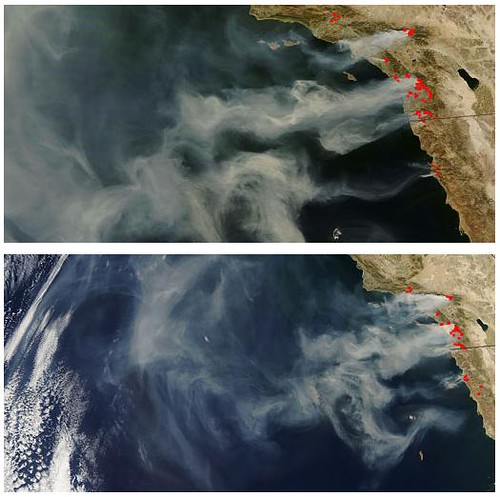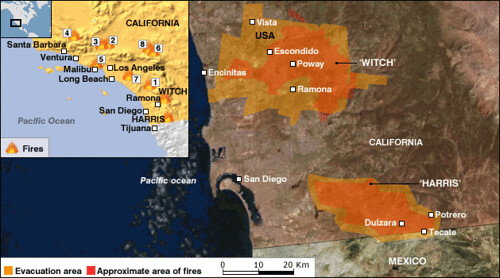tags: wildfire, California, aviculture, evacuation
Southern California state wildfires (red dots) as seen from a satellite. The smoke plumes are being blown out over the Pacific Ocean. The National Interagency Fire Center reports that 12 large, uncontained fires have burned over 335,000 acres in Southern California and these fires have continued to spread due to fierce, dry Santa Ana winds.
The first image was captured by NASA's Terra satellite at 2:25 p.m. EST on October 23, 2007. The second image was acquired by NASA's Aqua satellite at 5:40 p.m. EST, just over three hours later.
Image: NASA [slightly larger view]
Many of my avicultural friends and colleagues are located in southern California, including several kind people who took care of some of my beloved lories for free when I first moved to NYC. They all have been evacuated from their homes -- often with only a few minutes' warning because the fires, pushed along by the hot, dry Santa Ana winds that can reach 100 mph (160 km/h) and can change direction quickly, are advancing so quickly. These winds, sometimes known as the "Devil's Breath", are common during this time of year in southern California but, because of the drought that has gripped the area for more than one year, these fierce winds have pushed flames long distances between Santa Barbara and Mexico.
This means that my friends were forced to leave their birds behind. Already, several good-sized collections that include some incredibly rare and endangered birds and parrot species, have been killed by the smoke and flames. Other flocks have been partially lost, and who knows how many more bird fatalities will occur in the following months due to the effects of smoke inhalation combined with stress?
Already, the 19 California fires have left three people dead and 38 people injured, scorched 300,000 acres (120,000 hectares), burnt 1,500 homes and are threatening 68,000 more, and have caused more than $1 billion in damages. More than 500,000 people have been ordered to evacuate -- the largest evacuation to ever occur in California state history.
Besides parrots and other birds, other animals are also being abandoned as their owners are given only minutes to evacuate. For example, there are plenty of horse breeders here, as well as exotic animal breeders who have monkeys, reptiles and other mammals. However, luckily, some animals are being evacuated [video 0:50].
My heart goes out to my avicultural friends in their time of sorrow and loss of their homes and bird collections. On the good side, they are using email lists and phone trees to organize emergency bird housing all along the west coast and in the state of Arizona for those who need this sort of assistance.
Southern California wildfire paths and resources are available on the web and are updated every 1-2 hours. The map can be viewed here and information can be read here.
Of the 19 total fires in California, there are ten that have burned more than 1,000 acres. They are;
Witch fire: 196,420 acres burnt in San Diego County and is only one percent contained; burnt 805 houses and approximately 100 businesses and another 5,000 houses are threatened; 500,000 people across the county have been evacuated.
Harris Fire: 73,000 acres burnt so far and is 10% contained; burnt at least 200 houses and another 1,500 houses and 500 businesses are threatened; killed one person injured 28, including seven firefighters.
Rice fire: 7,500 acres burned in San Diego county, 206 houses destroyed, 1,500 threatened.
Buckweed fire: 38,236 acres burnt, 94% contained. Evacuation orders lifted in most places.
Magic fire: 2,824 acres burnt, 93% contained.
Ranch fire: 51,337 acres burnt, 45% contained. Local evacuation orders in place. Cost of fire so far estimated at $4.5 million.
Canyon fire: 4,500 acres burnt, 75% contained. 600 houses threatened. Mandatory evacuation orders remain in area around Malibu. Estimated cost $4.2 million.
Slide fire: 5,119 acres burnt, fire uncontained. 200 houses destroyed or damaged, 4,000 are threatened.
Santiago fire: 18,000 acres burnt, 30% contained. Some 3,000 houses threatened. Estimated cost $1.3 million.
Grass Valley fire: 1,000 acres burnt north of Lake Arrowhead. 100 buildings have been destroyed, some 6,000 houses are threatened. Estimated cost $1 million.
Sources
In-text map and specific fire information was condensed from here, other information came from my friends who are living inside this nightmarish hellhole.



It is a continual wonder that people build homes in and amongst combustible vegetation in a desert that experiences many weeks of drying winds annually. FOREST magazine recently published an article on simple measures that can be taken to help ensure one's wilderness home will not catch fire, but the larger issue is human intrusion into a delicate and dangerous environment. The sheer scale of the disaster should impart lessons, but they will be forgotten soon enough. All I have to do is drive 45 miles down the Gulf Freeway to Galveston to see tens of millions of dollars of beach homes and palaces awaiting the storm surge of a major hurricane with the protection of at most a de minimis, artificial dune that looks more like a big sandpile.
I drove through some of this nightmare yesterday on my way back from Vegas. I grew up here in SoCal and have never seen anything like this in my life. Last weekend, when the weather forecasts were talking about the coming Santa Ana (Santana) winds, I knew it was going to be bad. Of course, I don't think anybody could have foreseen it being quite this bad.
The air here is bad. I have a headache and congestion from the smoke - and that is in Silver Lake, well away from the actual fires.
This is the worst firestorm in California history. Yet, if global warming model predictions are correct, this year is only the beginning.
please donate: http://www.redcross.org/donate/donate.html
and if you're interested to see what people are saying about it: http://www.utterz.com/~t-TOD10.24.07/rss.php
Joel Sax is blogging from the middle of the mess.
I'm sorry to hear about the lost birds and other animals.
How sad...
A friend of mine used to live in SoCal until about half a year ago. Although she's usually away at college this time of year, I always worried for her family. I'm relieved that they are not in that area anymore.
I am glad to hear some of the animals are being evacuated. It frustrates me that considering animal life (aside from pets) is no concern when there is human life at risk. Maybe someday "we" will be wiser.